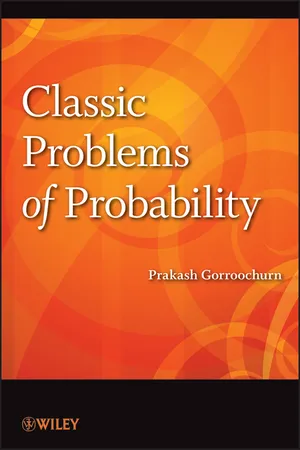
Classic Problems of Probability
Prakash Gorroochurn
- English
- ePUB (apto para móviles)
- Disponible en iOS y Android
Classic Problems of Probability
Prakash Gorroochurn
Información del libro
Winner of the 2012 PROSE Award for Mathematics from The American Publishers Awards for Professional and Scholarly Excellence.
"A great book, one that I will certainly add to my personal library."
— Paul J. Nahin, Professor Emeritus of Electrical Engineering, University of New Hampshire
Cl assic Problems of Probability presents a lively account of the most intriguing aspects of statistics. The book features a large collection of more than thirty classic probability problems which have been carefully selected for their interesting history, the way they have shaped the field, and their counterintuitive nature.
From Cardano's 1564 Games of Chance to Jacob Bernoulli's 1713 Golden Theorem to Parrondo's 1996 Perplexing Paradox, the book clearly outlines the puzzles and problems of probability, interweaving the discussion with rich historical detail and the story of how the mathematicians involved arrived at their solutions. Each problem is given an in-depth treatment, including detailed and rigorous mathematical proofs as needed. Some of the fascinating topics discussed by the author include:
- Buffon's Needle problem and its ingenious treatment by Joseph Barbier, culminating into a discussion of invariance
- Various paradoxes raised by Joseph Bertrand
- Classic problems in decision theory, including Pascal's Wager, Kraitchik's Neckties, and Newcomb's problem
- The Bayesian paradigm and various philosophies of probability
- Coverage of both elementary and more complex problems, including the Chevalier de Méré problems, Fisher and the lady testing tea, the birthday problem and its various extensions, and the Borel-Kolmogorov paradox
Classic Problems of Probability is an eye-opening, one-of-a-kind reference for researchers and professionals interested in the history of probability and the varied problem-solving strategies employed throughout the ages. The book also serves as an insightful supplement for courses on mathematical probability and introductory probability and statistics at the undergraduate level.
Preguntas frecuentes
Información






1.1 Discussion









- The definition given by Leibniz (1646–1716) in 1710 (Leibniz, 1969, p. 161):
- Jacob Bernoulli's (1654–1705) statement from the Ars Conjectandi (Bernoulli, 1713, p. 211)5:
- De Moivre's (1667–1754) definition from the De Mensura Sortis (de Moivre, 1711; Hald, 1984):
- The definition given in 1774 by Laplace (1749–1827), with whom the formal definition of classical probability is usually associated. In his first probability paper, Laplace (1774b) states:
Índice
- Cover
- Title Page
- Copyright
- Dedication
- Preface
- Acknowledgments
- Problem 1: Cardano and Games of Chance (1564)
- Problem 2: Galileo and A Discovery Concerning Dice (1620)
- Problem 3: The Chevalier de Méré Problem I: The Problem of Dice (1654)
- Problem 4: The Chevalier de Méré Problem II: The Problem of Points (1654)
- Problem 5: Huygens and the Gambler's Ruin (1657)
- Problem 6: The Pepys–Newton Connection (1693)
- Problem 7: Rencontres with Montmort (1708)
- Problem 8: Jacob Bernoulli and His Golden Theorem (1713)
- Problem 9: De Moivre's Problem (1730)
- Problem 10: De Moivre, Gauss, and the Normal Curve (1730, 1809)
- Problem 11: Daniel Bernoulli and the St: Petersburg Problem (1738)
- Problem 12: D'Alembert and the “Croix ou Pile” Article (1754)
- Problem 13: D'Alembert and the Gambler's Fallacy (1761)
- Problem 14: Bayes, Laplace, and Philosophies of Probability (1764, 1774)
- Problem 15: Leibniz's Error (1768)
- Problem 16: The Buffon Needle Problem (1777)
- Problem 17: Bertrand's Ballot Problem (1887)
- Problem 18: Bertrand's Strange Three Boxes (1889)
- Problem 19: Bertrand's Chords (1889)
- Problem 20: Three Coins and A Puzzle from Galton (1894)
- Problem 21: Lewis Carroll's Pillow Problem No: 72 (1894)
- Problem 22: Borel and A Different Kind of Normality (1909)
- Problem 23: Borel's Paradox and Kolmogorov's Axioms (1909, 1933)
- Problem 24: Of Borel, Monkeys, and the New Creationism (1913)
- Problem 25: Kraitchik's Neckties and Newcomb's Problem (1930, 1960)
- Problem 26: Fisher and the Lady Tasting Tea (1935)
- Problem 27: Benford and the Peculiar Behavior of the First Significant Digit (1938)
- Problem 28: Coinciding Birthdays (1939)
- Problem 29: Lévy and the Arc Sine Law (1939)
- Problem 30: Simpson's Paradox (1951)
- Problem 31: Gamow, Stern, and Elevators (1958)
- Problem 32: Monty Hall, Cars, and Goats (1975)
- Problem 33: Parrondo's Perplexing Paradox (1996)
- Bibliography
- Photo Credits
- Index